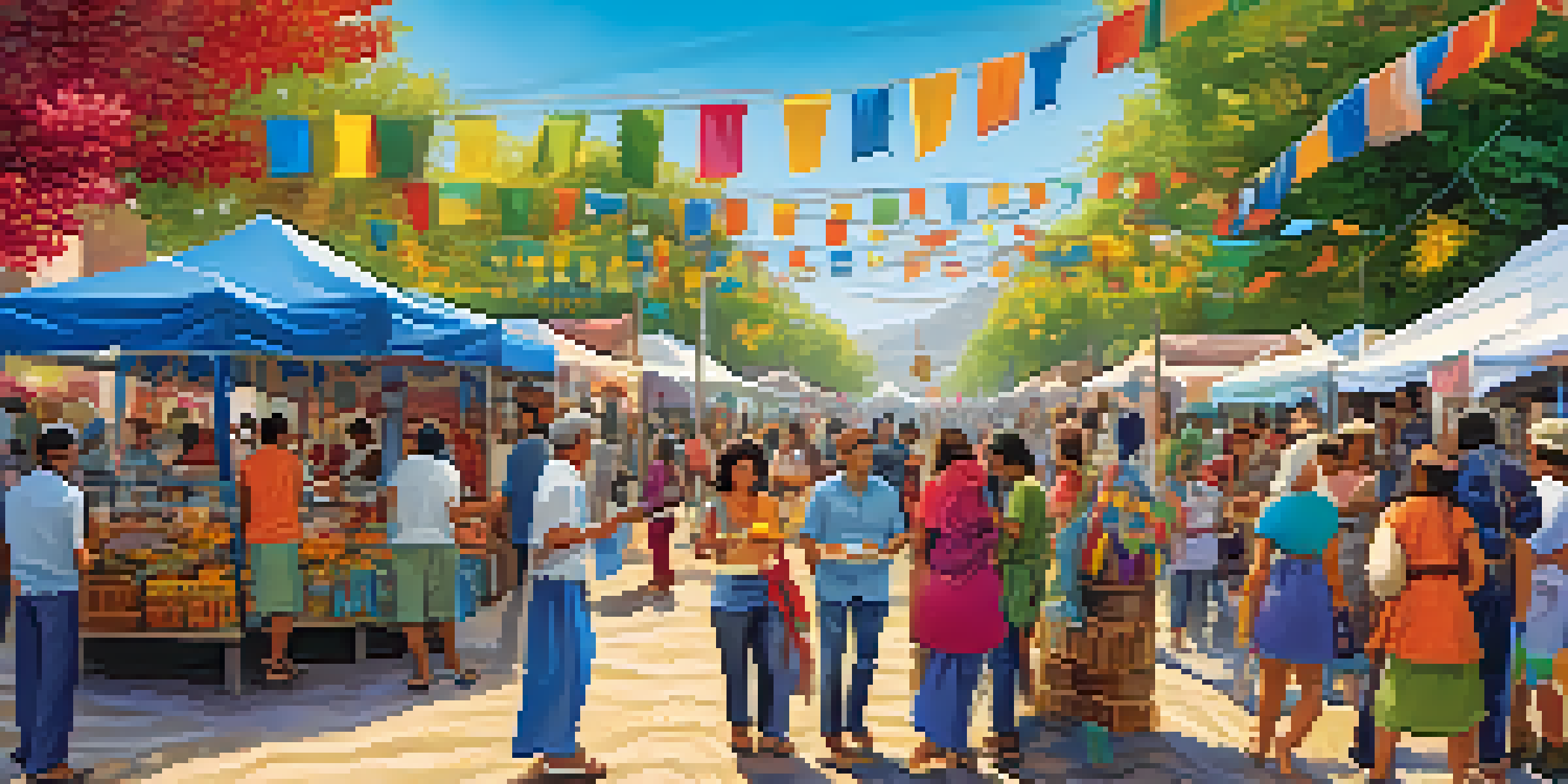Innovative Approaches to Engage Local Communities in Tourism

Understanding the Importance of Community Engagement
Community engagement in tourism is essential for creating a sustainable and authentic experience. When local residents are involved, they can share their unique stories and cultural heritage, enriching the visitor experience. This not only benefits tourists but also fosters a sense of pride among locals, making them active participants in their community's growth.
Tourism is not just about the places you visit, it's about the people you meet and the stories they share.
Moreover, engaging the community helps to build trust between tourism providers and residents. When locals feel valued and included in the tourism narrative, they are more likely to support initiatives that promote their culture and environment. This collaboration can lead to innovative ideas that enhance the overall tourism experience.
Ultimately, when communities are engaged, the tourism industry can thrive in a way that respects local traditions and contributes to economic growth. By focusing on community involvement, we can create a tourism model that is beneficial for everyone involved.
Leveraging Technology to Connect Locals and Tourists
In today's digital age, technology plays a crucial role in bridging the gap between locals and tourists. Mobile apps and social media platforms can serve as effective tools for sharing local insights, events, and attractions. For instance, a community-driven app can highlight lesser-known spots, encouraging visitors to explore beyond the typical tourist traps.

Additionally, virtual reality (VR) experiences can provide potential visitors with a taste of local culture before they arrive. By showcasing local traditions, food, and festivals through immersive technology, tourists can develop a deeper appreciation for what awaits them. This can lead to more meaningful visits and increased interest in engaging with the community.
Community Engagement Enhances Tourism
Involving local residents in tourism creates authentic experiences and fosters pride within the community.
Ultimately, technology can empower locals to take control of their tourism narrative, effectively marketing their unique offerings. This not only attracts tourists but also enriches the overall experience by fostering genuine connections.
Creating Community-Centric Events and Festivals
One of the most effective ways to engage local communities in tourism is through events and festivals that celebrate their culture. Organizing activities such as food fairs, craft shows, or cultural performances allows locals to showcase their talents while attracting tourists. These events can serve as a platform for storytelling, where residents share their history and traditions with visitors.
Sustainability is about the balance between the needs of the present and the future, and tourism must play a role in that balance.
Moreover, community-centric events can boost the local economy by promoting small businesses and artisans. When tourists attend these gatherings, they often purchase local goods, which directly benefits the community. This creates a win-win situation where visitors enjoy authentic experiences, and locals gain economic support.
By fostering a sense of pride and belonging, these events can help strengthen the community fabric. When residents see the impact of tourism on their lives, they are more likely to engage and collaborate with tourism stakeholders.
Supporting Local Artisans and Businesses
Tourism can thrive when local artisans and businesses are supported. By promoting local crafts, foods, and services, tourists gain access to authentic products, while the community benefits economically. For example, a tourism board can curate a directory of local shops and creators, making it easier for visitors to discover unique offerings.
Involving local businesses in tourism initiatives also leads to a more personalized experience for tourists. When locals share their stories and products, it creates a connection that enhances the visitor's journey. This not only fosters loyalty among tourists but also encourages repeat visits.
Technology Bridges Locals and Tourists
Digital tools like apps and VR can connect tourists with local culture, enriching their travel experience.
By championing local talent, communities can ensure that the economic benefits of tourism circulate within their area. This approach not only sustains local culture but also strengthens the identity of the destination.
Promoting Sustainable Tourism Practices
Sustainability is a key consideration in modern tourism, and engaging local communities is vital for promoting eco-friendly practices. By involving residents in the conversation, tourism initiatives can be tailored to meet both visitor expectations and local environmental needs. This helps create a balanced approach that protects natural resources while providing enjoyable experiences.
For instance, community-led conservation projects can invite tourists to participate in activities like beach clean-ups or wildlife monitoring. This hands-on involvement not only raises awareness about local issues but also fosters a sense of responsibility among tourists. When visitors actively contribute to the preservation of a destination, they develop a deeper connection to it.
Ultimately, promoting sustainable practices through community engagement leads to a more resilient tourism model. By prioritizing environmental stewardship, communities can safeguard their heritage for future generations while continuing to welcome visitors.
Encouraging Local Storytelling and Cultural Exchange
Storytelling is a powerful tool in tourism, and locals have the richest narratives to share. Encouraging residents to tell their stories fosters a sense of community pride and gives visitors a deeper understanding of the culture. This can be done through guided tours, workshops, or oral history projects that highlight local legends and experiences.
Cultural exchange programs can also create opportunities for tourists and locals to interact meaningfully. These programs can include cooking classes, traditional crafts, or language exchanges, allowing visitors to immerse themselves in the local way of life. Such interactions help break down barriers and build mutual respect between cultures.
Support Local Businesses for Growth
Promoting local artisans and businesses ensures that tourism benefits the community economically and culturally.
By prioritizing local storytelling, tourism can become a two-way street, where both visitors and residents learn from each other. This exchange enriches the travel experience and fosters a more inclusive tourism environment.
Building Strong Partnerships Between Stakeholders
Successful tourism initiatives require collaboration between various stakeholders, including local governments, businesses, and community organizations. By forming partnerships, these groups can pool resources, share knowledge, and develop strategies that benefit everyone involved. This collective approach leads to more effective tourism planning and execution.
For example, a partnership between local artisans and tourism boards can result in marketing campaigns that highlight unique cultural experiences. By working together, stakeholders can create a cohesive message that attracts tourists while showcasing local talent. This collaboration not only enhances visibility but also strengthens community ties.

Ultimately, building strong partnerships fosters a sense of shared purpose. When stakeholders unite to promote local tourism, they can create a more vibrant and sustainable industry that thrives on community involvement.